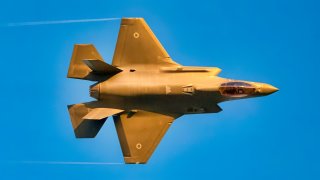U.S. Military Declares F-35 No 'Paperweight' and One of the 'Best Aircraft'
The Lockheed Martin F-35 Lightning II continues to face scrutiny over its high costs and operational challenges, as highlighted in a recent Government Accountability Office (GAO) report which pointed to increasing sustainability costs and decreased operational plans due to reliability issues.
Summary: The Lockheed Martin F-35 Lightning II continues to face scrutiny over its high costs and operational challenges, as highlighted in a recent Government Accountability Office (GAO) report which pointed to increasing sustainability costs and decreased operational plans due to reliability issues.
-In response, U.S. Secretary of Defense Lloyd J. Austin III defended the aircraft during a House Armed Services Committee hearing, emphasizing its significance in the U.S. military's arsenal and ongoing efforts to improve its performance.
-The report criticized the F-35 for not meeting its availability goals and pointed to a trend of decreasing mission capability despite rising costs. Despite these challenges, the Department of Defense remains committed to the F-35 program, with substantial budget allocation aimed at ensuring U.S. air dominance, including ongoing upgrades like the Technology Refresh 3 (TR-3), which is expected to enhance the aircraft's capabilities significantly.
F-35 Lightning II: Operational Challenges and Defense Department's Commitment Explained
The Lockheed Martin F-35 Lightning II remains a lightning rod for criticism, with some lawmakers claiming the fifth-generation stealth aircraft is too costly and even unreliable. However, on Tuesday, United States Secretary of Defense Lloyd J. Austin III pushed back on criticism from lawmakers and defended the aircraft and the entire F-35 program.
"I would not categorize the F-35 as a paperweight," Austin responded to questions from Rep. Matt Gaetz (R-Fla.) during a House Armed Services Committee hearing on the Department of Defense's fiscal 2025 budget. "It is one of the best aircraft in the inventory."
Concerns about the capabilities of the F-35 Lightning II aren't new but have received increased attention after the Government Accountability Office (GAO) released a new study that found the fifth-generation multirole fighter was costing more, yet being used less.
"DOD's projected costs to sustain the F-35 fleet keep increasingfrom $1.1 trillion in 2018 to $1.58 trillion in 2023. Yet DOD plans to fly the F-35 less than originally estimated, partly because of reliability issues with the aircraft. The F-35's ability to perform its mission has also trended downward over the past 5 years," the GAO report warned. "We have consistently found that the F-35 fleet is not meeting its availability goals, which are measured by mission capable rates (i.e., the percentage of time the aircraft can perform one of its tasked missions), despite increasing projected costs."
Lloyd said he agreed with the GAO's criticism, but said that efforts were underway to address the issues.
"It's a complex airframe," added Austin. "There are a number of reasons why a platform could be not operational at any one given time."
The secretary of defense also noted in his written testimony that the fiscal year 2025 (FY25) budget calls for more than $61 billion to "assure U.S. air dominance," including for the F-35.
"We continue to work to make sure that we get our aircraft operational," Austin further told lawmakers.
F-35 Program Delay
Among the biggest concerns with the F-35 is the delay of the Technology Refresh 3 (TR-3), which will provide the Lightning II with greater capabilities.
This upgrade is crucial for enhancing the jet's digital infrastructure and weapon systems. As reported by Stavros Atlamazoglou for The National Interest, TR-3 "will upgrade the F-35’s onboard digital infrastructure, improving its data storage and processing capabilities; and improve the user interface, thus making the pilot’s life easier. The new software will also enable the stealth fighter jet to carry new air-to-air and air-to-ground weapons, sensors, and cyber countermeasures."

Atlamazoglou added, "Complicating matters even further is the fact that the upcoming Block 4 upgrade needs the TR-3 as a software upgrade as a base."
The United States Department of Defense (DoD) had refused to accept newly built F-35s due to problems with the software, and the resolution has slipped several times from the expected April 2023 release date. TR-3 is now projected to be completed sometime this summer – but not earlier than July, and possibly as late as September.
Author Experience and Expertise: Peter Suciu
Peter Suciu is a Michigan-based writer. He has contributed to more than four dozen magazines, newspapers, and websites with over 3,200 published pieces over a twenty-year career in journalism. He regularly writes about military hardware, firearms history, cybersecurity, politics, and international affairs. Peter is also a Contributing Writer for Forbes and Clearance Jobs. You can follow him on Twitter: @PeterSuciu. You can email the author: [email protected].
Image Credit: Shutterstock.


